|
|
| << PREV |
|
|
Never in the history of man has so terrific a
calamity befallen the race as that which all who
look may now behold advancing as a deluge,
black with destruction, resistless in might,
uprooting our most cherished hopes, engulfing
our most precious creed, and burying our highest
life in mindless desolation.... The flood-gates of
infidelity are open, and Atheism
overwhelming is upon us.
GEORGE ROMANES
(personal friend of Charles Darwin; 1878, 51)
Thomas Huxley, bulldog and champion of Darwin, had a high regard for
the Bible, although like Isaac Newton and others before and since, he could
not accept the possibility that natural laws had been violated by supernatural
intervention. The Virgin Birth and the Resurrection were usually held in
a peculiar dichotomy of mind, at the same time both believable and unbelievable,
but such items as ex nihilo
Creation, the Fall of man, the Genesis
Flood, and the New Testament miracles were quite unacceptable. Upon the
death of his young son in 1860, Huxley described his religious views to
Rev. Charles Kingsley, and by the 1880s many others were prepared to admit
openly these same convictions which were, by then, termed "agnosticism".
Huxley had said that he was prepared to follow his intellect as far as
it would go but stop short of accepting conclusions that were not clearly
demonstrable. For Huxley, agnosticism was an attitude of healthy skepticism,
a tool of the intellect, essential to the working scientist. Moreover,
as a newly coined term it had none of the stigma of "unbeliever" or "atheist",
and in Victorian society that was important in order to be accepted socially.[1]
In his later years, Darwin was approached by Edward Aveling, Karl Marx's
son-in-law, who extended the hand of greeting to a fellow atheist, but
Darwin corrected his inquirer by referring to himself as an agnostic.[2]
Writing of this meeting some years later, Aveling consoled himself by pointing
out that "Atheist is only Agnostic writ aggressive, and Agnostic is only
Atheist writ respectable" (Aveling 1897, 1:323). In the final analysis,
and from Huxley's definition, the existence of God and anything beyond
material phenomena is not clearly demonstrable, so that the shades of difference
between agnostic and atheist blend and can no longer be discerned.
Theistic Evolution
In the wide spectrum of beliefs, ranging from those accepting literal fiat Creation to the rank atheist for whom the only explanation for our origins is materialistic evolution, there is a school of belief that characterizes liberal Christianity and is known as theistic evolution. This school places belief in evolution first and by whatever the latest scenario demands: that is, orthodox Darwinism, neo-Darwinism, punctuated equilibria, etc. There is the concomitant belief in the Deity and the thought that he directed the process of evolution to bring about planet earth and all living things. The entire first eleven chapters of Genesis, including the creation of Adam and Eve, the Fall of man, the Genesis Flood, and the Tower of Babel, are denied and relegated to myth, allegory, or fable. Theistic evolution acknowledges intelligent design, but the Designer's involvement extends from virtually none at all in the Deist position, in which God is limited to initial creation of the universe only, to the full theistic position. At the full theistic end of the involvement spectrum, God is responsible for directing evolution of one species to another in a series of steps, while the last of these steps was the creation of humanoid characteristics in selected anthropoid bodies (Adam and Eve).
The subscriber to theistic evolution would seemingly welcome the latest
theory of punctuated equilibria (see Chapter Six) as evidence of the Creator's
intervention in the natural selection process, but then the theistic model
begins to enter a philosophical minefield. Adopting the theory of punctuated
equilibria to explain the gaps in the fossil record is safe enough, but
when evolution is said to be an ongoing process today (the peppered moths
are always cited), then the Creator's intervention is also brought into
the present day, and for some this becomes an uncomfortable realization.
The thought of being observed and accountable to an omnipresent Judge definitely
interferes with lifestyle. For this reason theistic evolution usually stops
at the Adam and Eve stage, while only the bold, willing to dispute the
veracity of the Scriptures with the Deity himself, will concede to divine
intervention in the affairs of nature and man into this present age.
| Unitarian Origin of Theistic Evolution
One of the earliest and most active advocates of theistic evolution was Darwin's American correspondent, Asa Gray. A Harvard professor of botany, he was, to some extent, one of the founding fathers of the theory of evolution and from 1860 on became Darwin's promoter, ambassador, and apostle in the United States. Although a lifelong Congregationalist, Gray's faith was undoubtedly affected by his wife, Jane, who was a devoted Unitarian and attended the services at Harvard College Chapel (Dupree 1959, 182).[3] Asa Gray's new gospel contributed not a little to Harvard University's stature as the American center of Unitarian thought. Gray was concerned about the absence of transition fossils to support Darwin's theory, while at the same time he was more positive than Darwin and saw in nature evidence of intelligent design. Darwin confessed to being in "an utterly hopeless muddle" over the question of design.[4] Conscious that literal belief in the Bible ran very high in America, Gray was concerned that, for this reason, Darwin's theory with its atheistic overtones would not be accepted by the majority of people. He wrote: "Since atheistic doctrines of evolution are prevailing and likely to prevail, more or less among scientific men [Gray was promoting the Origin at the time], I have thought it important and have taken considerable pain to show that they may be held theistically" (Dupree 1959, 359). Gray conceived the view that all these difficulties could be solved at one stroke. The hand of the Deity was, of course, responsible for design, but might also be invoked to explain the missing fossils and persuade the atheist away from his position. The Christian community would thus find Darwin's theory more palatable. Gray explained the position in a private letter: |
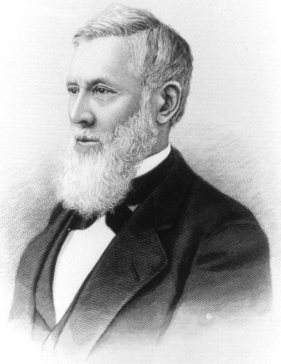
Asa Gray, 1810-88, a Harvard professor of botany, tried to reconcile Darwin's natural selection with Christianity's belief in supernatural intervention and finished by being true to neither. (Photogravure of the subject at fifty-seven; Metropolitan Toronto Reference Library Board) |
The important thing to do is to develop aright evolutionary teleology, and to present the argument for design from the exquisite adaptations in such a way as to make it tell on both sides; with Christian men, that they may be satisfied with, and perchance may learn to admire, Divine works effected step by step, if need be, in a system of nature; and the anti-theistic [atheistic] people, to show that without the implication of a superintending wisdom nothing is made out, and nothing credible (J. L. Gray 1893, 2:656).[5]
The "step by step" process is the supposed divine intervention in
normal chance variation to purposefully direct one species to become another.
John Dewey, the founder of the American liberal education movement, later
referred to this as "design on the installment plan" (Dewey 1951, 12).
Gray's noble intentions were nevertheless seen by some to be an attempt
to smuggle Paley's watchmaker into Darwin's natural selection.
Gray (1861) exerted considerable influence by written articles,[6] and he tried to persuade Darwin to adopt his position of theistic evolution. Darwin quickly saw through the fallacy of Gray's argument, however, and rejected it outright. In a letter written to Lyell in 1861, he said, "The view that each variation has been providentially arranged seems to me to make Natural Selection entirely superfluous, and indeed takes the whole case of the appearance of new species out of the range of science".[7] Darwin later made his views very clear to Gray.
An interesting aside here is that Darwin attached an historical sketch to the fifth (1869) and sixth (1872) editions of his Origins, in which he quoted Aristotle as the classical forerunner of his own view that chance and chance alone was responsible for natural selection (p. xv). This was Darwin's only reference to the Greek philosophers, and in that he tripped up rather badly. He had taken the quote from Aristotle's Physics, where Aristotle (1961 ed., 36) set out Empedocles' argument for chance processes and then proceeds to show how impossible this must be.[8] Aristotle had always maintained that nature herself is the builder, proceeding according to an inner plan and idea (teleology) and always striving after the better. Whether we call that inner working nature, an intelligence, or plainly God, this is theistic evolution and was precisely the view that Darwin would not entertain, in spite of the fact that he had paid lip service to the Creator in the conclusion to the Origin (Darwin 1860, 488).[9] He had taken Aristotle out of context and turned him on his head to support his own theory of evolution based on chance.
Darwin publicly rejected Gray's argument when, on the last page of his Variation of Animals and Plants Under Domestication, published in 1868, he concluded, "However much we may wish, we can hardly follow Professor Asa Gray in his belief in lines of beneficent variation" (Darwin 1868, 2:428). Asa Gray's theistic evolution was not only rejected by Darwin, but also was never seriously considered by any of the other founding fathers of evolution.
Darwin had put his finger on the fundamental problem with theistic evolution, and it recalls the proposition made by the poet Lucretius more than two thousand years ago. Lucretius visualized primeval space to be occupied by free-falling atoms and said that only by the deviation of some atoms at some time from their straight course, a moment mutatem, could a creative process begin (Lucretius 1951, 66). The parallel here is that free-falling atoms and chance variation in nature are both dynamic processes under nature's rigid law. This is evolution and no teleological process is involved -- that is, there is no final design, no end purpose, built into the species to determine what they will ultimately become. Once intelligent direction by some spiritual agency is admitted, however, then the free-falling atoms of Lucretius will deviate from their path, and chance variation will become purposeful change. With this modicum of control, no matter how slight, evolution based on pure chance eventually falls apart. The rigid law of nature is broken, experience becomes unrepeatable, future results unpredictable, and man eventually loses control in all empirical inquiry.
The dilemma then facing Gray, though he seems not to have recognized it, was that either he believed that God was in control, in which case he could not genuinely call himself a believer in evolution -- Darwin himself made this clear -- or he could believe in evolution and concede that God had no control in the process whatsoever. In short, nature's laws, universal in time and space, are either laws or they are not, and, ultimately, the proponents of punctuated equilibria will have to face this same question.
So much for the problem from the point of view of reason, but there were equally fundamental problems from the point of view of revelation, as the theologians of the day were quick to point out. Denying the first eleven chapters of Genesis, they said, was bad enough, but seven of the eight New Testament writers (all but James) referred affirmatively to these chapters, in a total of thirty-two verses.[11] Casting suspicion on these authors as either fools or liars then placed the whole of the New Testament in doubt, including all the words of Christ, since it was either spiritually inspired and the truth or it was not.
But worse than all this, the literalists thundered from their pulpits,
was that denial of Adam meant that Christ himself was denied. Their argument
ran that denials of the literal truth of the third chapter of Genesis entailed
a denial of an actual man, Adam, of his disobedience, and of mankind's
subsequent fall. This being so, there was no need for redemption or a Redeemer.
This was plainly a rejection of the very core of the Christian faith (Bozarth
1978, 30).[12] Nevertheless,
times have changed, and in these days of enlightenment, such railings against
the doctrine of theistic evolution, which were loudly heard in the 1860s,
are almost an anachronism. Should a lone apostle have the temerity to bring
this same message to the liberal church today, it would be regarded as
the outworkings of lunacy touched, perhaps, by the petulance expected from
a dyspeptic eunuch.
Asa Gray's Followers
Asa Gray became necessarily coy when faced with admitting that, from
his position, the ape was our Adam. This was, perhaps, not too surprising
since he was employed by Harvard University. As pointed out earlier, Harvard
was by now strongly committed to the Unitarian faith yet the science faculty
at this time had become a bastion of anti-Darwinism in America. This situation
was caused by the faculty being dominated by its most famous professor,
Louis Agassiz, a committed Christian who was vigorously opposed to Darwin.
Agassiz died in 1873 and thus left professor of Botany, Asa Gray, a few
unhindered years to promote the new gospel. Harvard has long since been
totally
committed to the evolutionary faith in all faculties.[13]
However, about a day's journey away, at Yale University, James Dana, professor
of geology, found no such restrictions and fearlessly proclaimed man's
ancestry to the ape. Like Darwin, Dana had been on a four-year voyage around
the world, and then, for a further four years had traveled across America
for the newly formed Smithsonian Institution, gathering geological information
for the building of railways. Dana was a Christian and, at first, a follower
of Cuvier, but after reading the Origin he did some soul searching
and became a convinced Darwinist, holding to Gray's position of theistic
evolution. Although he was no Huxley, Dana almost single-handedly converted
Yale University from the orthodox Christian belief to evolution by using
Gray's argument that evolution could be supported theistically. Dana's
pride was that he had made Yale a stronghold of evolutionary science to
"correct false dogma in the theological systems" (Wendt 1968, 259).
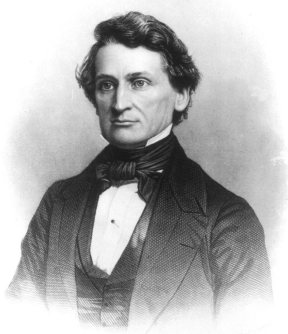
James Dana, 1813-95. Yale professor of geology and confessed Christian fearlessly proclaimed the new gospel of theistic evolution, claiming man's ancestry to the ape. (Engraving by A.H. Ritchie from a daguerrotype by Moulthiol; Yale University Library Archives) |
Little by little the American clergy began to bend to Dana's
promulgation of Gray's theistic evolution. The silver tongue of the most
popular American evangelist of the day, Henry Ward Beecher, argued convincingly
that the theory of evolution was the key to many secrets of nature and
a constant revelation to man of the works of God (Beecher 1885; Stowe 1934;
Caskey 1978). In England, Beecher's counterpart was the fiery Henry Drummond,
who took the message of theistic evolution to the university students and
in 1873 joined the evangelical movement led by Dwight L. Moody as his lecturer
on natural science.
In the early 20th century another notable American preacher to bring reconciliation between evolution and Christianity was Harry Emerson Fosdick of the Riverside Church in New York City. He was a liberal actively opposed to the fundamentalists for more than two decades. After causing several uproars by preaching against Special Creation, he was asked to resign from his first church in 1922.[14] With financing by John D. Rockefeller Jr., he had the inter-denominational Riverside Church built for his own use and for the next twenty years brought the modern gospel message to listeners every week on a nationwide radio program. |
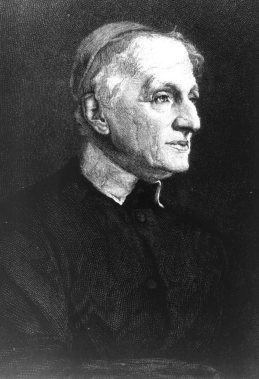
John Henry Newman, 1801-90. Drummed out of the Anglican Church for his attempts to reintroduce Roman Catholic traditions and doctrines, he later became a cardinal in the Roman Church in England. (Engraving by T. Cole after the portrait by Ouless; Metropolitan Toronto Reference Library Board) |
Newman had anticipated the theological outworkings of Darwin's
Origin
by
almost a decade in his proposition that the Christian doctrine had developed,
i.e. evolved (Lash 1975).[15]
In this he was several years ahead of his time, and the idea was carried
with him into the Roman Church. After the publication of the
Origin,
the
Vatican deliberated on its moves for fourteen years before Pope Pius IX
issued the "Syllabus of Errors", condemning "progress, liberalism and modern
civilization". This was generally understood to be in reference to Darwinism,
although it did not actually say so; surprisingly, neither the Origin
nor
the Descent
were placed on the Catholic Index.
Newman became cardinal in 1877, and his notions of the development of theology as man's mind developed paved the way for others in the church hierarchy to accept biological development. The works of Darwin thus began to take their place beside the very books they denied in the private libraries of bishops and prelates, and eventually these thoughts began to spill across the pulpit to the people. Catholicism has always placed a greater dependence on the authority of the church than on Scripture and, without specific condemnation of Darwin, Catholics were free to explore evolutionary lines of inquiry so long as they were from the theistic viewpoint. By 1950 Pope Pius XII was sufficiently concerned to issue the encyclical Humani Generis, which soundly condemned the evolutionary teaching, in the key passage stating the reason: |
Some imprudently and indiscreetly hold that evolution which has not been fully proved even in the domain of natural sciences ... and audaciously support monistic and pantheistic opinion that the world is in continual evolution. Communists gladly subscribe to this opinion so that, when the souls of men have been deprived of every idea of a personal God, they may the more efficaciously defend and propagate their dialectical materialism (Carlen 1981, 175).
| However, the Jesuit left arm of the church was evidently not
working in accord with the papal right, and, as we shall see, it is clear
that the Jesuit view has prevailed.
The philosopher, paleontologist, and Jesuit, Pierre Teilhard de Chardin (1881-1955), produced one of the most esoteric versions of theistic evolution, combining within it elements of eastern mysticism. It will be recalled from Chapters Eight and Nine that the good priest was involved in the Piltdown man affair and the dubious circumstances surrounding Peking man, while his superiors never seemed to have attained to his degree of enlightenment -- he was exiled twice, the first time to China and the second time to the Wenner-Gren Foundation in New York (Speaight 1967). As a student, Teilhard had been influenced by philosophy professor Henri Bergson's L'Evolution Creatrice (1907), and for the remainder of his life he had built on Bergson's principle of orthogenesis, that is, of an intelligent guiding principle in evolution rather than chance.[16] |
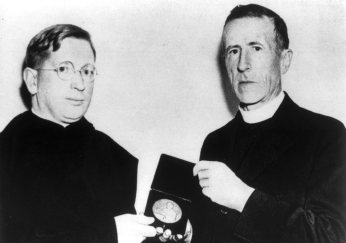
Pierre Teilhard de Chardin, 1881-1955, shown on the right receiving the Mendel medal in Philadelphia, March 1937, from Fr. Edward V. Stanfort in recognition for his contribution to science. (New York Herald Tribune) |
The culmination of Teilhard's thinking on theistic evolution is contained in his Phenomenon of Man (1955), while a more explicit work entitled Christianity and Evolution was published posthumously in 1969.[17] Since then, and with the aid of several small but organized bands of followers,[18] Teilhardian evolution has diffused not only in England but throughout the Catholic West (Glick 1976). An interesting development soon took place. In 1957 the Holy Office ordered the works of Teilhard removed from the libraries of Catholic institutions and forbade their sale in Catholic bookstores. At this date the Catholic Index of Forbidden Books was no longer being kept. This was followed by a letter or monitum, in June 1962, advising the faithful of errors and ambiguities in Teilhard's writings (Masala 1962).[19] At the same time, however, the Jesuit arm of the Roman Catholic Church produced a stream of literature defending Teilhard's writings and actively promoted his works (Kopp 1964).[20] The effect has been that evolution has been considerably depolemicised in most intellectual and educational sectors of the Catholic world, while the monitum is now, clearly, a dead letter.
Theistic evolution, with a bias towards the Teilhardian view, has thus become firmly established within the Roman Catholic Church, and, in retrospect, this might be expected since the long and posthumous shadow of Aristotle is still cast over Rome. It will be recalled from earlier chapters that Aristotle's ideas, including his concept of teleology in nature, were carried forward by Thomas Aquinas and became integrated within the foundation of Catholic teaching. However, this must cause a mental schism in any who stop to think about what is actually being said. This "doublethink" situation will be apparent when it is recalled that theistic evolution of any kind does not accept the first eleven chapters of Genesis, but at the same time the original commandment to "be fruitful and multiply" (Genesis 1:28) in the first chapter is rigidly upheld by the prohibition of birth control. Examples could be multiplied.
If Teilhardian evolution is on poor ground theologically, it is revealing
to read of opinions of his views in scientific circles. Sir Peter Medawar's
now famous critique of Teilhard's Phenomenon of Man leaves prospective
readers with an accurate picture of what to expect. Medawar begins:,
It is a book widely held to be one of the utmost profundity and significance ... some reviewers hearabouts have called it the Book of the Year -- one, the Book of the Century. Yet the greater part of it ... is nonsense, tricked out by a variety of tedious metaphysical conceits, and its author can be excused of dishonesty only on the grounds that before deceiving others he has taken great pains to deceive himself... but consider first the style, because it is the style that creates the illusion of content (Medawar 1961, 99).
As in modern art Teilhard has become a cult figure to a circle of
devotees who give the benefit of any doubt in his writings to profundity
rather than confess to their total incomprehensibility. Indeed, incomprehensibility
is the most marked characteristic of authors writing in support of theistic
evolution. The reader can usually be sure that if what is being said is
not absolutely clear on first reading but is couched in long and tortuous
terms, then it is fairly certain that some version of theistic evolution
is being promoted.
More serious than small groups of misguided intellectuals is the fact
that the Communist party has recognized the usefulness of theistic evolution
for its own purposes. Today, they are actively promoting Teilhard's work
among Christian intellectual centers and particularly among Catholics in
Europe and South America (Garaudy 1968; Kristof 1969; Lischer 1979).[21]
The Marxist element in the Jesuit teaching order has recently been well
documented by Martin (1978) and is the vehicle primarily responsible for
bringing theistic evolution to today's generation. The founding father
of communism, Karl Marx, recognized that "religion is the opium of the
people" (Marx 1843).[22]
He further recognized that religious beliefs stood in the way of the vision
for a new world order, while heading that list of religions was Bible-based
Christianity. Direct persecution has, since Roman days, proven ineffective,
serving only to reinforce the faith of the survivors; the alternative strategy
adopted today is deliberate erosion of belief from within the Christian
organizations. Evolution now has the respectability of science, and for
the Catholic Christian particularly, Teilhard's theistic evolution appears
as the perfect compromise, with just enough science tempered with just
the right amount of religious mystery. With the church's sanction and blessing,
what more could the layperson ask? As we saw in the Humani Generis and
as we shall see later, there is a very short step between theistic evolution
and the outright atheism of the Communist party; the next generation should
see some very interesting developments between the Communist governments
and Roman Catholic Church.
Theistic Evolution in the Protestant Churches
Within the Protestant English church, Anglican Charles Kingsley was an early admirer of Darwin and, as we have noted earlier, confessed upon reading the Origin, that he had long "learnt to disbelieve the [biblical] dogma of the permanence of species".[23] As with many intellectuals of his own class, rather than adopt the then currently popular Day-Age and Gap theories, he chose the position of theistic evolution as the rational alternative to Special Creation.
Another influential advocate of Darwin was the ordained Anglican Oxford professor, Baden Powell, father of the founder of the Boy Scout movement. Elected to the Royal Society while still a vicar in 1824, he was an admirer of Lyell's uniformitarianism and one of the first major theologians to adopt Chambers' Vestiges (1844). Miracles of any kind were inconceivable to Powell, and he considered the entire Old Testament to be irrelevant (Powell 1857).[24] Not surprisingly, he was opposed to the evangelicals and often involved in religious controversy. One of the great scandals was caused by Powell's review of the Origin when it first appeared. Powell took the theistic position and wrote a glowing review indicating how much greater God was from Darwin's evolutionary viewpoint than from questionable Jewish records. A few years earlier the church would have condemned Powell as a heretic, but in 1860, although it was controversial, his view was tolerated.
Interestingly, at the very same time there was another Anglican churchman
who as less cavalier towards the Old Testament than Powell and yet who
suffered greater censure by his church. John Colenso, educated at Cambridge,
became Bishop of Natal and set about to translate the Bible into Zulu.
It was during this time that he discovered what he considered to be discrepancies
in the early books of the Old Testament and published a critical examination
in The Pentateuch and the Book of Joshua. This caused so much controversy
that in 1860 there was a public trial and the Bishop of Cape Town, as his
Metropolitan, declared that he be deposed. Five years later, after the
issue had settled down, an appeal was made to the Privy Council and the
disposition declared void. Colenso kept his job. Why the fury of church
authority was directed to Colenso and not Powell is not clear; perhaps
a scape-goat had to be found.
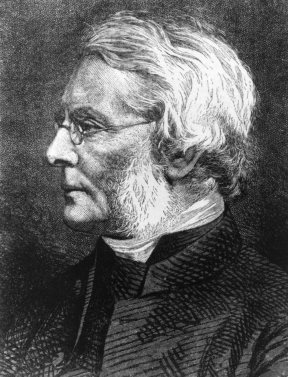
John Colenso, 1814-83. Dispatched from England to become the Bishop of Natal, he was later denounced for expressing far less serious doubts than were being publicly expressed by more senior members of the church hierarchy. Was he being made a Anglican scapegoat? (Metropolitan Toronto Reference Library Board) |
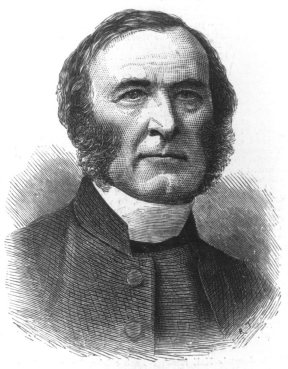
Frederick Temple, 1821-1902. Headmaster of Rugby School, Bishop of London, and finally Archbishop of Canterbury; one wonders if this highly successful advancement in power would have been achieved had he not been a follower of Darwin. (Metropolitan Toronto Reference Library Board) |
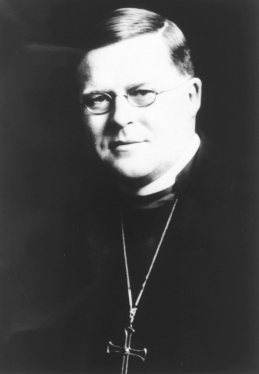
William Temple, 1881-1944. Son of Frederick Temple, he closely followed in his father's footsteps, becoming Archbishop of Canterbury in 1942. Author of the thoroughly Darwinian Nature, Man and God and contributor to several left-wing magazines, he master-minded the British Council of Churches and later the World Council of Churches. (Photograph by Bassano, Camera Press; Miller Services) |
One thing is certain, however, Colenso's trial brought tremendous
newspaper publicity at precisely the time of the public outcry against
the Origin. The most notable statement made by Colenso at his trial
was: "The 'scandal' they complain of is not caused by me, but by those
who maintain a state of things in the Church opposed to the plainest results
of modern science" (Cox 1888, 1:236). This won many sympathizers, and the
affair served extremely well from three aspects: it temporarily diverted
attention from the criticism aimed at the Origin, it focused on
the apparent unsoundness of the Bible, and it won many converts to Darwin.
In sum, the publicity could not have come at a better time to aid the establishment
of evolution.
One by one theologians gave in to Darwin's evolution through the theistic argument. It all seemed so rational, and it removed the necessity to have to confess to those embarrassing miracles. The most effective converts were those near the top of the ecclesiastical pyramid, since by their influence they controlled the dogma of the incoming generation of theologians. Frederick Temple was headmaster of Rugby School when he compromised his faith with Darwin in 1860.[25] He steadily rose through the ecclesiastical ranks to become Archbishop of Canterbury in 1896, the highest position in the Anglican Church (Temple 1860). The theistic version of Darwin's evolution thus began to filter down as acceptable dogma among the hierarchy before the turn of the century. In fact, by the time Darwin died in 1882 and despite all the outcry there had been a quarter of a century earlier over his Origin, the church now insisted that he be given a hero's funeral and state burial at Westminster Abbey. Yesterday's heresy had become today's divine truth. |
It will never be known how many defections from the church were caused
by this reversal of stand, but it did cause many of the bitter disputes
within the church, the conservatives holding to the literal truth of the
Genesis record of Creation pitted against the Liberals holding to theistic
evolution. These same tensions still exist today, not only within the Christian
church but also in the orthodox Judeo and Islamic worlds, while the point
at issue is still revelation versus reason.
| From Evolution to Atheism
At first Darwin's Origin was primarily accepted not on any scientific merit but rather because it offered an apparently rational alternative to the miraculous; the early followers were, therefore, not the scientists of the day but rather theologians who found themselves in the profession for any number of personal reasons, the least of which was they had been "called" to that vocation. There was no doubt much truth in the Victorian quip that the fool of the family was either sent into the army or the church, and Charles Darwin's father may have considered these alternatives when he sent young Darwin to Cambridge for clerical training. Darwin's followers each had their particular motive: some, like Huxley, because the theory was anticlerical and others simply because it was antiestablishment. Perhaps the most notable was Karl Marx, at the time living in London and attending Huxley's public lectures on Darwinian evolution. Marx found the struggle-to-the-death principle in natural selection a perfect confirmation of his own view of man's class struggle and, in appreciation, sent Darwin a copy of his Das Kapital, in 1873 -- it had been published in 1867 (Padover 1979, 139).[26] Six years later, Marx wrote to Darwin requesting permission to dedicate his next volume to him; however, Darwin declined the offer explaining "that it would pain certain members of his family if he were associated with so atheistic a book" (Keith 1955, 234). Darwin would turn in his grave if he knew of the excesses his theory has been asked to justify in this twenty-first century! |
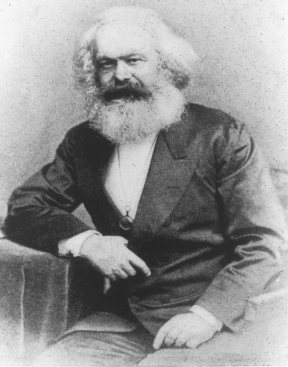
Karl Marx, 1818-83. Born to Jewish parents, he became a Christian, studied philosophy, and turned his back on any kind of theism. He was expelled from Germany for his political views and found refuge in Victorian London. (Metropolitan Toronto Reference Library Board) |
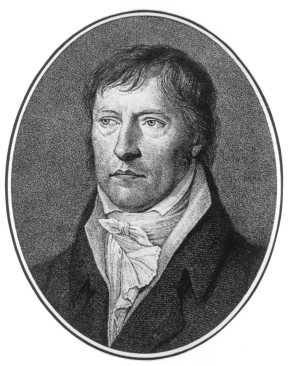
Georg Hegel, 1770-1831. Introduced the idea that God is a world-spirit present in all natural processes. The outcome of this thinking is pantheism or nature worship, while Jesus becomes merely an enlightened teacher. Engraving by Bollinger after Xeller. (John P. Robarts Research Library, University of Toronto) |
The Karl Marx incident is an appropriate point at which to introduce
the German philosopher Georg Hegel, whose ideas not only greatly influenced
Marx but also many German free-thinkers in the nineteenth century. In Hegel's
philosophy, God did not exist over and above the world as in Christian
orthodoxy, but was rather a world spirit found in the depths of all natural
processes. All reality was simply a manifestation of this world spirit,
referred to, in sum, as the Absolute Spirit, while religion was an imaginative
and pictorial way of representing the truth of this philosophy.
Hegel visualized the Absolute Spirit to be directing an ongoing developmental (evolutionary) process in nature, including humanity, while that process had taken an irregular course of continuing ascent. The upward path was seen to be one of a dialectical struggle between positive and negative entities, but the outcome was always to produce a balanced, harmonious synthesis -- something better. Ultimately, perfection would be reached. Writing more than a century later, Teilhard de Chardin called this ultimate goal Point Omega. If all this sounds vaguely like Asa Gray's theistic evolution, it is, essentially, just that, although Hegel had reduced the Christian God almost beyond recognition to a mere impersonal intelligence directing the destiny of nature. |
Hegel's ideas were developed before Lyell wrote his Principles, but they lay waiting for science to catch up to philosophy before they could come to full fruition. Once the development process (evolution) appeared to have support from science, Hegel's philosophy became popular in Germany. However, it was but a short step then to say that the Absolute Spirit directing nature was none other than Nature herself. Charles Kingsley's transition from Father God to Mother Nature may be recognized as an instance of this subtlety. Ludwig Feuerbach, a student of Hegel, made this transition more boldly and then explained away four millenia of man's relationship to God by saying that God was really only the projection of man himself. Theology, thereby, became anthropology. George Bernard Shaw expressed the concept, in his usual witty way, half a century later by saying that God was made in the image of man -- a parody of Genesis 1:27. At this point God's function in the thinking of Hegel's followers was virtually redundant, and in 1882 Friedrich Nietzsche took it upon himself to take the final step and pronounce that God was dead (Nietzsche 1882, 3:108).[27] Coincidentally, this was the same year that Darwin died while, as if under a divine curse, Nietzsche lost his professorship and was eventually declared to be hopelessly insane. Nietzsche died a few years later. It had taken less than a generation from the time Hegel's philosophy had been given credibility by Darwin's Origin to the formal declaration of atheism. Only acceptable to the apostate extremists at first, the high road to atheism had been established, and now, through the new world order set out by Karl Marx (1850) in his Communist Manifesto, man was seen to be at last totally freed from the shackles of religion.[28]
It should be emphasized that Darwin's primary concern was for his theory.
The fact that the theory provided some with a rational justification to
reject God may have given him concern at first, but it seems to have passed
with time and the acceptance of his theory by his peers. In the meantime,
Haeckel was working hard in Germany and Huxley in England promoting the
theory of evolution by presentation of evidence in books and public lectures
for the working classes. As we have seen throughout these chapters, this
nineteenth century evidence, used so convincingly to destroy the faith
of those who would listen, has since been shown to be completely invalid.
But there were still many who clung doggedly to their Bibles, totally unconvinced
and unmoved by science; it was for such as these that there arose in Germany
towards the end of the nineteenth century a handful of theologians who
took it upon themselves to destroy credibility in most of the early books
of the Bible.
Biblical Evolution
Julius Wellhausen (1844-1918) was a brilliant German theologian who, it is said, occupied a position in the field of Old Testament study analogous to that of Darwin in the area of biological science. As a student, Wellhausen's ideas had been conditioned by the evolutionary concepts of Hegel, who maintained that man had ascended from primitive beginnings. This was quite contrary to the biblical teaching of the Fall of Man, but the steady pressure of geological evidence by Lyell's interpretation, followed by the biological evidence by Darwin's interpretation, had by this time relegated the Genesis Flood to myth in the minds of many. The first five books of the Old Testament claim to have been written by Moses, and since these books contain the accounts of Creation, the Fall of man, and the great Flood, they now became suspect and the legitimate object of intellectual inquiry. Others, such as Graf, working before Wellhausen, had developed a scholarly approach for the analysis of the Hebrew texts in which the books of Moses were written, an approach that eventually became known as Higher Criticism.
Wellhausen's followers, well versed in this albeit useful type of analysis, adopted the assumption that because the more significant Mosaic laws and regulations were neglected for prolonged periods in the early history of the Israelite nation -- that is, in the fourteenth to tenth centuries, B.C. -- Moses could not have introduced these regulations prior to this time during the Exodus in the fifteenth century (Harrison 1970, 127). Although the actual time of the Exodus has still not been settled, Harrison, a respected Old Testament scholar, has made it clear that this assumption is "wholly fallacious" (Harrison 1969, 20).[30]
Wellhausen assumed that there had been a progressive development of religious practices by absorbing ideas from surrounding cultures until from polytheistic beginnings they had emerged as a monotheistic nation. At this point, it was argued, certain priestly editors, writing perhaps as late as two centuries B.C., ascribed all the regulations and monotheistic theology that had developed to the quasi-mythical patriarch, Moses. The Wellhausen school maintained that by diligent analysis of the Hebrew Scriptures, the characteristics of the individual editors could even be identified; these were referred to as J, E, D, and P. Enormous volumes of literature and Ph.D. theses have since been generated by this line of inquiry, which became known as the Graf-Wellhausen Developmental or Documentary Hypothesis. Graf was acknowledged as one of the early workers in this field. The hypothesis was based squarely on Hegelian evolutionism and commended itself to many who sought to solve problems by a single interpretive principle (Driver 1891).[31]
The Developmental Hypothesis seemingly gained support from archaeological
findings of the day. It will be recalled that Layard discovered a whole
"library" of clay tablets at Nineveh, and although no one could read the
cuneiform inscription at the time, George Smith, an engraver working at
the British Museum, eventually discovered the key, and by 1872 a most exciting
discovery had been made. A Babylonian narrative, very closely resembling
the Genesis account of Noah, the ark, and the great Flood, appeared recorded
in the ancient tablets (Ceram 1971a, 276).[32]
The conservative scholars said that this was a corrupt account of an earlier
version that had been preserved in its pure form by the Hebrews. The liberal
scholars of the Graf-Wellhausen school, on the other hand, claimed that
the Hebrews had taken it from the earlier Babylonian version and that this
was one of the most convincing pieces of evidence for the Developmental
Hypothesis. Their argument was that the archaeologically dated earlier
version ascribed the Flood to the caprice of one among many gods (polytheism),
while the later Hebrew version ascribed it to judgment by one supreme God
(monotheism), thus showing the evolution of the higher concept.
| The liberal scholars of the late nineteenth century eventually
gained the upper hand, filling all the key posts at the theological colleges,
while conservative scholars were not promoted and assumed the lower positions
(Lindsell 1976).[33]
As one generation of students passed into the next, the teachings of Graf
and Wellhausen became established dogma, and the result was a growing disbelief
not only in the book of Genesis but in the entire Old Testament.
A particularly effective means of broadcasting the liberal interpretation of the Bible opened up, either fortuitously or by some manipulation, in the appointment of William Robertson Smith as joint editor and then chief editor of the prestigious Encyclopaedia Britannica in 1881. Smith was a brilliant theologian, Semitic scholar, philologist, physicist, and archaeologist, to whom the miraculous was totally unacceptable. He wholeheartedly adopted the Developmental Hypothesis and expressed this unorthodox interpretation in his article on the Bible in the ninth edition of the Britannica (known as the "Scholars edition"), published at that time in England over the period 1875-89. There were cries of outrage from the public who still retained the orthodox view, but, nevertheless, the die had been cast, and the ninth edition would stand as the font of all truth and knowledge on countless library shelves in most English-speaking countries for at least another generation. |
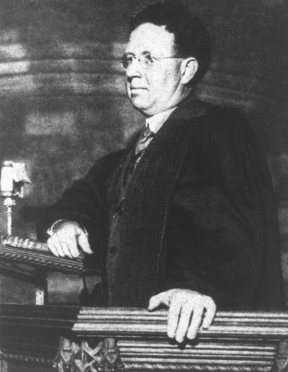
Harry Emerson Fosdick, 1878-1969. Gifted speaker and tireless worker for the liberal church, he preached and broadcast the message of theistic evolution in America for more than twenty years. (Keystone Picture Agency) |
Smith's service to the cause completed, the controversy caused him to
be expelled from his chair in the Free Church College at Aberdeen, Scotland,
and he died at the early age of forty-seven. A second, very effective means
of broadcasting the liberal gospel took advantage of the technology of
the 20th century to reach the listener rather than the reader. Harry Emerson
Fosdick, mentioned earlier in this chapter, conducted a nationwide radio
broadcast every week from 1926 to 1946. This served well to establish the
view that the early books of the Bible were steeped in myth and legend,
while most of the books of both the Old and New Testaments had been written,
even edited, hundreds of years after the events they describe. This message
became entrenched in the young minds of those who have since become today's
leaders in many, if not most, of America's theological schools and seminaries
where the Developmental Hypothesis is still taught.
Hypothesis Not Supported by the Facts
Ever since Darwin's Origin gave credence to the Hegelian notion that human culture had ascended from brutal beginnings, there has been a running controversy among archaeologists working in areas that provide the biblical background. The liberal element has tended to look for evidence to support the Developmental Hypothesis and ignore that which refutes it, whereas the more competent workers have not set out with the idea of proving one view or the other, but simply to draw objective conclusions from all the facts. Chief among these latter scholars was the towering figure of William Albright, a man with prodigious mental capacities and reputedly familiar with more than twenty-five languages. As a result of his work and influence on Palestinian archaeology from 1920 to 1940, Harrison (1969, 60) makes the statement that all books written about Old Testament history and archaeology before 1940 must be regarded as obsolete. This effectively casts aside all the archaeological evidence which, it was claimed, supported the Developmental Hypothesis. A vast amount of hard evidence has been acquired during the past half century that confirms the accuracy of the early books of the Old Testament, while even some of the early narratives of the book of Genesis have been clearly vindicated (Kitchen 1978, 26).[34] Radday (1982) has recently carried out a computer analysis of the Hebrew words of Genesis and has shown, beyond doubt, that the book had but a single author.[35] This confirms the conservative traditionalist view while refuting the liberal view of multiple authorship and, naturally, has wrought further controversy within the scholarly ranks.
Harrison (1969, 61) pointed out several years ago in his now classic
work on the Old Testament that in spite of the overwhelming archaeological
evidence supporting biblical accounts, there are still some who exercise
a studied disregard for the evidence and prefer subjective speculations
such as the Developmental Hypothesis. Often, however, the confirmatory
evidence tends to remain in the relative obscurity of the scholarly journals,
while the outdated liberal view is the one conveyed to the general public
by the popular press (Magnusson 1977).[36]
Among numerous major discoveries, such as those at Mari, Nazu, Ugarit,
the Dead Sea scrolls at Qumran, and more recently those at Tell Mardikh
(Ebla), each has confirmed the biblical accounts and established the traditional
dating; the Mosaic laws were given to the Israelites before they
became an established nation and not centuries after, and the New Testament
record was written within the lifetime of eye witnesses and not centuries
later, as has been claimed. However, it is the evidence for the Genesis
account of a universal flood that is the most vital from the point of view
of Lyell's geology and, subsequently, Darwin's theory. Naturally, this
is a very sensitive area, and the evidence can only be circumstantial,
but, nevertheless, it should not be suppressed but brought into the light
of day, where the reader may judge for himself.
James Frazer and the Flood
The Genesis account of the great Flood is not a piece of folklore confined to a small tribe of Israelites. Oral and written accounts are found throughout the world. Before the days of the ubiquitous Coca-Cola machine or even the radio, when some human cultures were still untainted by Western ideas, anthropologists sought out remote tribes and diligently recorded their oral traditions. They were careful to note any evidence of borrowing from other cultures including any influence of missionaries, who were then just beginning to fan out into places such as "darkest Africa". All this work was carried out early in the nineteenth century, and James Frazer, later Sir James Frazer, brought it all together in his massive three-volume work Folklore in the Old Testament, published in 1918.[37] This work includes 138 flood accounts from the north, south, and central Americas, from all over the Pacific islands, India, China, and from the less populous parts of Europe. Each account has obvious elements of fantasy and local coloring, but throughout, and almost without exception, there are four basic themes common to them all and common to the Genesis account. First, there was a moral cause for the flood, either because of the misconduct of men or the misconduct of the gods. Second, all accounts agree that either a god or an animal gave one man advance notice of the flood. Third, without exception, all agree that the flood wiped out all of mankind except those specifically warned and that these survivors are the progenitors of the present world population. Fourth, the animals played a significant part by giving warning of the flood or by indicating that the flood waters had abated and that dry land had appeared. In addition to these four basic themes, a great many of the stories mention or imply that eight people were saved while almost all say that some kind of vessel was used to house the survivors (Custance 1979, 88).[38]
The conclusion to be drawn from the fact that all the accounts have
certain important features in common is inescapable. Since the stories
are worldwide and yet speak of a specific incident happening at the time
of a great catastrophe, this indicates not only a large element of truth
but a common geographical origin for mankind. The Genesis account places
this origin at the triple-point of eastern Turkey, southern Armenia, and
northern Iran -- probably one of the most politically sensitive areas in
the world today.
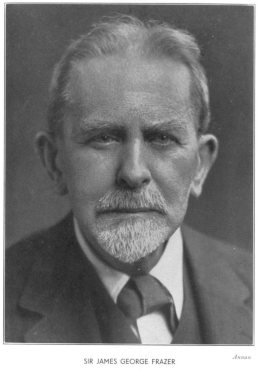
James Frazer, 1854-1941. A Scottish anthropologist and academic who spent more than sixty years in the libraries of Cambridge University undermining by scholarship the literal interpretation of the Bible. (Lafayette, London) |
A notable postscript to the veracity of these flood legends lies,
ironically, in the motives of their editor, Sir James Frazer, who is perhaps
better known for his great anthropological essay The Golden Bough,
published
in 1890 and still available in reprinted editions today.[39]
Sir James Frazer was the dutiful and obedient son of staunch Presbyterian
parents who were strictly orthodox in the Calvinist tradition; his early
home life centered around daily worship and good reading. As a child he
never dreamed of questioning parental or religious authority. As a man,
however, he spent more than sixty years in the libraries of Trinity College,
Cambridge, undermining belief in a literal acceptance of the Bible. His
quiet and persistent rebellion, effected through scholarship, produced
such works as the collection of flood traditions, which in fact, and in
spite of Sir James, remain as a testimony to the authenticity of the Genesis
account (Kardiner and Preble 1961, 78).
It is appropriate to mention at this point that of all the numerous stories, deathbed confessions, and even a sample of hand-tooled wood and faked photographs that have resulted from the search for Noah's ark on Mount Ararat over the past century. So far there is not one shred of evidence, let alone proof, that an ancient vessel resides on the mountain (Montgomery 1972).[40] As previously mentioned, this geographical area is a politically sensitive region, formerly having a Russian missile base on the on the Armenian side of Ararat and latterly a preserve of the Kurds in their war against the Turks. This is all in addition to the physical difficulties of the area that make exploration hazardous. Nevertheless, we may be sure that if the ark is ever discovered and unquestionable proof furnished, this will create the greatest controversy ever heard, because the whole of Lyell's geology and the evolution dogma will then have to face their most serious challenge. |
The Ebla Controversy
One of the greatest archaeological discoveries of the 20th century began in 1964 at Tell Mardikh, located about one hundred and fifty miles north of Beirut in northern Syria. Just when biblical scholars believed they had everything finally in place for Israel's earliest period, that is, for the time of Abraham, the discovery of a mighty Canaanite empire, with its all but forgotten capital city of Ebla, made history books obsolete once again. Until this discovery, the conventional thinking was of the Egyptian kingdoms to the south and the Assyrian empire to the north with nothing very much in between; but now the biblical land of Canaan, part of which later became Israel, was found to be a major empire competing in trade with others around it.
A team of Italian archaeologists, working in cooperation with the Directorate General of Antiquities and Museums of Syria, made international news in 1975 when Ebla's royal archives were unearthed, containing the greatest cache of inscribed tablets ever discovered (Pettinato 1976). There were more than 15,000 clay tablets and fragments, which will take years to translate, but these have already revealed that Ebla was a cultural and trade center of some quarter million people. Ebla flourished at the time the Egyptians were building the earliest pyramids at Gizeh, believed to be about 2500 B.C. The key member of the Italian team, Dr. Giovanni Pettinato, had been superbly prepared, as one of the few scholars fluent enough in the key languages, to unlock the secrets of Ebla. He soon began to find names and statements from the cuneiform script that appeared to confirm the early biblical accounts. This kind of discovery was, naturally, of great interest to many people and caused the most bitter controversy between the conservative scholars, who were pleased to find confirmation of the early biblical accounts, and the liberals, who still subscribed to the Developmental Hypothesis. To make matters worse for the outside world, the Syrian government took exception to the tenor of these reports on political grounds and imposed a virtual news blackout on the work at Tell Mardikh in the late 1970s (Mikaya 1978).
Some of the dust surrounding the Ebla discoveries has since settled,
and with the simultaneous publication of two books by the principal investigators,
a fair notion of the truth of the matter can be discerned. Paolo Matthiae
represents the liberal school and, in the preface to his Ebla: An Empire
Rediscovered, cautions the reader:
Polemics often harsh and always painful for the author have arisen from individual speculations about presumed connections between the Ebla texts and Biblical characters, stories and episodes. The interest aroused among the public by these unfounded inferences of a relationship between Ebla and the Bible is understandable, but it must clearly be said that documentary evidence of them is effectively non-existent (Matthiae 1981, 11).
Giovanni Pettinato (1981), on the other hand, represents the conservative
view and, in his Archives of Ebla,
quietly presents the sifted and
incontrovertible evidence.
In the first place, the discovery of 114 bilingual dictionaries and the very sophisticated handling of trade and commerce leaves no doubt that the scribes were proficient in several languages and that the arts of writing and computing were highly developed (Pettinato 1981, 235). All this existed at least a thousand years before the time of Moses (circa 1500 B.C.), who, we are told, received the best of Egyptian education. This evidence alone should be sufficient to refute the Developmental Hypothesis, which claims that the art of writing was not sufficiently developed at the time of Moses and that the early books of the Bible ascribed to him were merely passed on by oral tradition.
Of more specific interest was the discovery of two copies of the Babylonian
Gilgamesh epic, which is a pagan version of the biblical Flood, and three
beautifully preserved copies of a creation account that bears close resemblance
to the account in the first chapter of Genesis (Pettinato 1981, 238). Pettinato
provides the translation to this remarkable hymn of praise written, it
will be recalled, a thousand years before the biblical text and thus completely
refuting the notion of oral tradition:
Lord of heaven and earth
the earth was not, you created it
the light of the day was not, you created it,
the morning light you had not (yet) made exist.
(Pettinato 1981, 244)
The Eblaite account of creation is also dramatically different from
the later creation records, such as the Babylonian Enuma Elish and
the Epic of Atrahasis, which date about 1600 B.C. and have grotesque
absurdities such as gods fighting and cutting each other in half, making
the earth from one half and heaven from the other. Clearly, the more elegant
account is the most ancient and does not support the evolutionary notion
of the ascent of man (Heidel 1963).[41]
| Genesis in China
There is a final illustration of the fact that the Genesis accounts of Creation and the Flood were not confined to the oral tradition of an obscure tribe of Hebrews. This is to be found, of all places, in the old Chinese written characters. The Chinese can authentically boast of 4,500 years of unbroken civilization, and it is believed that they originally migrated from a site in Mesopotamia because of similarities to the later Babylo-Assyrian culture in arts, sciences, and government (Sayce 1893).[42] The approximate date of their origin, 2500 B.C., is coincidental with the beginnings of many other civilizations in the Middle East and India. The Chinese written language, which it is believed developed at about the same time, is based on pictographs, or stylized pictures representing things such as people, trees, houses, etc., while the more complex ideographs use combinations of pictographs to express ideas. Chinese rulership has always been extremely bureaucratic, laying down rules and regulations for every detail of life. This applied also to the thousands of written characters, which became standardized in the second century B.C., long before Christian missionaries. These characters remained virtually unchanged until the Chinese Communist reforms, which began about 1948. |

The Chinese ideographs prior to the simplification
|
When the Christian missionaries entered China and began to learn the
written language in order to produce the Bible for the Chinese, it was
discovered that the Chinese ideographs for many ideas specific to creation
and the flood accounts already existed. Moreover, these ideographs contained
a recognizable "picture" of the Genesis meaning. For example, the ideograph
for the word "ark", as in Noah's ark, consisted of a symbol for a boat
plus symbols for eight mouths or people (Kang and Nelson 1979, 95). It
is surely more than coincidental that in the Hebrew version eight people
were saved in the ark. For the past two thousand years, China has nurtured
three religions that have essentially become fused into one, all three
often being found in the same temple. Confucianism, which is really a philosophy,
entered China about 500 B.C., while Taoism and Buddhism (Buddhism admits
of no Supreme Being) entered during the first century B.C. Prior to this
time, the Chinese empire served only one God; they had no myths or idols
and kept a strict moral code. They called their god Shang-Ti, meaning heavenly
emperor (Tax and Callender 1960, 3:13).[43]
Once more, the Developmental Hypothesis, which declares that man began
in barbarous beginnings worshipping many gods (polytheism) and then ascended
to higher cultures in which only one god was worshipped (monotheism), has
been shown to be untrue. In China, they began with one god and degenerated
to many gods with Taoism.
Evolution, a Basis for Religion
The point was made at the beginning of the previous chapter that man has an innate tendency to worship some being greater than himself. The narrow use of the word "worship" was then broadened and found to apply to many fields not normally considered to be religious. Each case involved affirmation of a position adopted without proof.
Evolution by its very comprehensiveness makes it impossible to prove
or even test scientifically. Evolutionists Birch and Ehrlich have remarked:
Our theory of evolution has become ... one which cannot be refuted by any possible observations. Every conceivable observation can be fitted in to it... No one can think of ways in which to test it. Ideas, either without basis or based on a few laboratory experiments carried out in extremely simplified systems, have attained currency far beyond their validity. They have become part of an evolutionary dogma accepted by most of us as part of our training (Birch and Ehrlich 1967, 352).
One of the most respected biological evolutionists of today, Ernst
Mayr, has stated, "The basic theory [of evolution] is in many instances
hardly more than a postulate and its application raises numerous questions
in almost every concrete case" (Mayr 1963, 8). A postulate is a supposition
assumed without proof; the truth of Mayr's statement may be evident from
those pieces of evidence offered as "proof" in the past, such as Bathybius
haeckelii, the vestigial organs, development of the embryo, and the
numerous fossil men, each of which eventually turned out to be misrepresentation
or even fraud. If the "proof" in the past was spurious, it might be asked
if genuine proof has been offered more recently, but there is, as yet,
no affirmative answer. Colin Patterson, senior paleontologist at the British
Museum of Natural History, should be in a position to know, yet declared
before his peers at a meeting in 1981 that evolution was "positively anti-knowledge",
saying that "all my life I had been duped into taking evolution as revealed
truth" (Patterson 1981, 2).
The attempt to provide proof by expanding the definition of the term "species" was evidently not acceptable to Erhlich, Mayr, or Patterson, and until concrete proof is provided, it has to be concluded at this point that evolution is a belief system held to by faith. Of course, the Creation account is similarly a belief system held to by faith, and the parallel may be recognized that neither explanation for origins has been observed, neither can be tested in the laboratory, and neither is refutable; that is, neither explanation can be proved or disproved.
A second parallel involves the appeal to the supernatural. There has never been any dispute about the role of the miracle in the literal interpretation of the Genesis account, first for Special Creation and then for the great Flood. The theory of evolution makes no less of an appeal to the miraculous, as may have become evident throughout the previous chapters. The odds against the right combination of elements joining together in the right order for the first living cell to appear from nonliving matter are so enormous that it can only be concluded to have been miraculous. Some, such as Nobel prize winner Francis Crick, are fully aware of these odds and, unable to accept the miraculous, have turned to extraterrestrial sources for the beginning of life. Many other examples run through these pages, such as the unvarying energy output by the sun for several billion years and the very finely balanced population growth over several hundred thousand generations -- clearly appealing to the miraculous. A prominent British biologist and Fellow of the Royal Society has also observed these parallels in his introduction to the 1971 reprint of Darwin's Origin of Species. Professor Harrison Matthews stated there that "belief in the theory of evolution" was "exactly parallel to belief in special creation", with evolution simply "a satisfactory faith on which to base our interpretation of nature" (Darwin 1971, x). The theory of evolution, then, cannot properly be included in the field of science, which deals with the physical universe, since it is a non-physical belief (Harper 1979).[44 ] Belief is a thing of the human mind and determines the way in which we interpret the physical things about us; some will see a fossil as the result of the Genesis Flood, others will see the same fossil as evidence of evolution.
Faith in a belief system takes us beyond science into the metaphysical and, thereby, into the realm of religion. Many writers are beginning to recognize this; for instance, historian and philosopher of science Grene says, "It is as a religion of science that Darwinism chiefly held, and holds, men's minds. The derivation of life, of man, of man's deepest hopes and highest achievements, from the external and indirect determination of small chance errors, appears as the keystone of the naturalistic universe" (Grene 1959, 48). Macbeth (1971, 124), a nonreligious critic, notes that Darwinism itself has all the attributes of a religious faith and lists five major points, one of which is that the true disciples manifest an outright contempt for Christianity. For example, those holding a belief in biblical Creation are today rooted out of teaching positions with the same righteous fervency as the heretics were at one time rooted out of the church. Thus the ongoing evolution-creation debate, which has been blowing hot and cold ever since Darwin's Origin, is clearly a matter of two diametrically opposed belief systems or religions: atheism on the one hand and theism on the other.
The central issue in this debate is the belief in the existence of a Supreme Being. Julian Huxley, grandson of Thomas Huxley and one of the foremost evolutionists of his day, was an unabashed atheist. He pointed out in 1959 that Darwin's real achievement was to "remove the whole idea of God as the Creator of organisms from the sphere of rational discussion" (Tax and Callender 1960, 3:45). The belief in a Supreme Being may at once be recognized as the one essential characteristic of a theistic religion. It is perhaps surprising, however, to find that the belief in the nonexistence of a Supreme Being is also considered to be a (nontheistic) religion. Thus, atheism was formally declared to be a religion by the United States Supreme Court in 1961, together with Buddhism, Ethical Culture, Secular Humanism, and others that do not teach a belief in the existence of God (Bird 1979).[45] The Atheist Church of America and the American Ethical Union, for example, are both bona fide tax-exempt religious organizations.
The fully committed Darwinian, such as Julian Huxley, forthright enough to confess his belief, is clearly in the atheist camp,[46] while those holding to the literal interpretation of the Genesis Creation account are in the theist camp. Many in the theist camp are committed Christians, but they are not alone, for it also embraces members of the orthodox Jewish and Islamic faiths. However, those holding to belief in theistic evolution, no matter how seemingly reasonable and popular, are not really true to either camp. In this position, the foundation for Christianity has been replaced by Darwin, while still retained is an illusion of a prayer-hearing God. The illusion becomes evident when it is conceded that divine intervention ceased after the creation of Adam and Eve. Theistic evolution is clearly only a stepping stone to ease the theist into a new faith whose foundation is evolution. That new faith is not necessarily outright atheism, since this is only for the very few, for the dedicated purist. It is tailor-made for those for whom there is still a need to satisfy the worship principle.
That spiritual aspect will more often than not be met by the would-be worshiper turning to occult practices. This was true in the case of the Nazi party members in Germany, was true in the case of Communist Party members in Russia, and is a growing trend among members of the liberal church in the West.
We shall see in the next and final chapter that the new faith is secular
humanism in which man replaces God and declares himself to be free at last
to be master of his own destiny.
|
|
| << PREV |
|